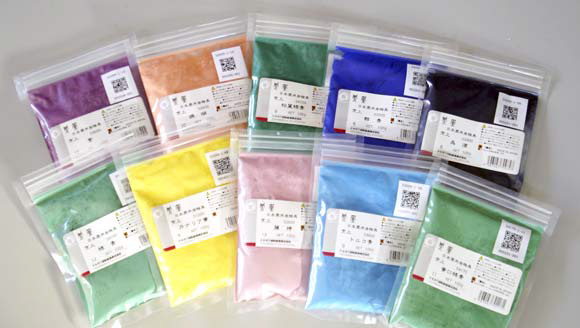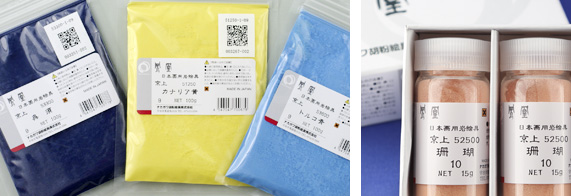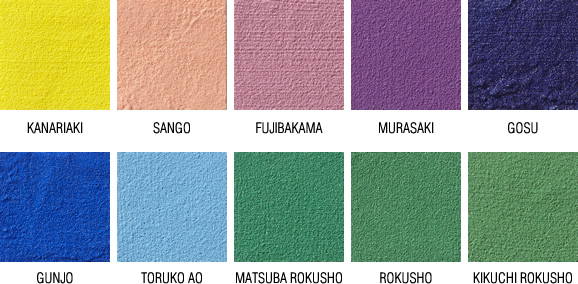HOME > Starting Nihonga > Pigment > Kyojyo Iwa Enogu
Kyojyo Iwa Enogu
![]()

Nakagawa Gofun Enogu, in collaboration with the Kyoto Prefectural Technology Center for Small and Medium Enterprises successfully commercialized lead-free Iwa Enogu (currently 10 colors). In 2011, we began manufacture and sale of this product as Kyojyo Iwa Enogu.
Since long ago, Japanese people have said that premium Nihonga should not be taken near hot springs which release sulfur – that is how sensitive the pigments used in Nihonga are considered to be – however in recent years the possibility of equivalent damage occuring even away from hot spring areas has been pointed out. For this reason, it was essential to clarify the reactive mechanism of atmospheric pollutants and Shin Iwa Enogu elements and develop new pigments with functions and properties able to withstand poor environments.
Kyojyo Iwa Enogu development originated from a joint development project with Kyoto Prefectural Technology Center for Small and Medium Enterprises into “New Iwa Enogu Virtually Unaffected by Atmospheric Polluting Gases”. This research investigated the impact of acid precipitation caused by atmospheric pollutants such as sulfuric gas and nitrogen oxide on pigment elements as well as methods to prevent such impact.
From around 1992, Kyoto Prefectural Technology Center for Small and Medium Enterprises have been studing technologies to prevent lead release for pigments used in ceramics and the impact of environment-polluting gases and had already developed and patented a highly chemical resistant frit pigment for application in the ceramics industry.
In 1998, utilizing this research accomplishment for Shin Iwa Enogu used in Nihonga, we at Nakagawa Gofun Enogu developed [Environmentally-Responsive Functionality Frit Pigment] able to withstand sulfuric gas, nitrogen oxide and so forth. In 2002-03, we researched a [Pigment with Low Melting Functionality with Resistance to Hydrogen Sulfide Gaseous Enviroments]. Hydrogen sulfide is known as an environment-polluting gas with strong reducing performance.A multifaceted investigation of painting materials was carried out, covering the impact of nitrogen dioxide gas and so on.
These research efforts led to the development of an environmentally-responsive low melting function frit pigment and finally stirred hope regarding prospects of a new Nihonga pigment considering environmental performance.

The lead-free Iwa Enogu commercialized after 10 years of development is not only able to prevent environmental pollution by being virtually uneffected by atmospheric polluting gases, but is also superior from the perspective of safety for people involved in its manufacture and use. Moreover, the development and production of new colors is possible due to the ability of lead-free Iwa Enogu to be darkened, something which could not be achieved with conventional Iwa Enogu. This product is also superior from a cost perspective.
Nakagawa Gofun Enogu has registered this lead-free Iwa Enogu as the trademark “Kyojyo Iwa Enogu” and, in parallel to exploiting demand in the conventional Iwa Enogu market, is planning an increase of demand as a next-generation painting material.
We will also proactively engage in product development targeting overseas markets such as Europe, America and China to which export of conventional pigments was difficult due to environmental restrictions.
Literary sources: “The Front Line of Japanese Art Education – A Report from the Kyoto Techniques & Materials Research Association” - care of the Kyoto Techniques & Materials Research Association
“An Outlook of Kyoto Industries”- 2005 Edition, excerpt of the 5th volume on Management Innovation through Recognizing the Uniqueness of Small and Medium Enterprises – Chapter 1 Industry, Academia and Government Collaborations, Case Study 2 The Convergence of Industry, Academia and Government Collaborations and Traditional Pigments
There are currently 10 types of Kyojyo Iwa Enogu colors, beginning with Kyojyo Canary Yellow*.
We will aim to develop and commercialize 30 types with 10 tones each, making a total of 300 colors.
*Current as of February, 2014

Product introduction > See here for details on Kyojyo Iwa Enogu
